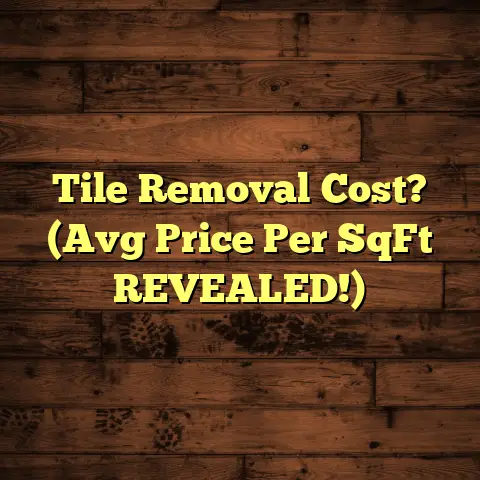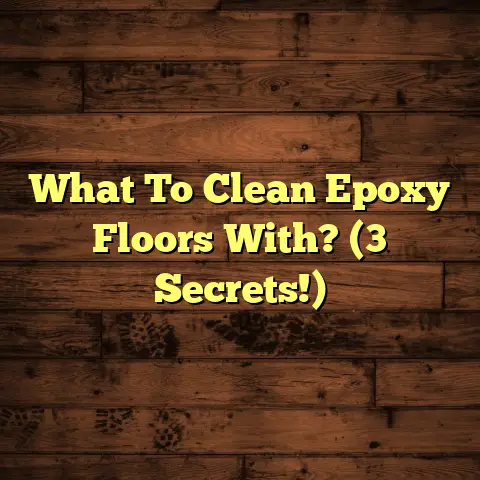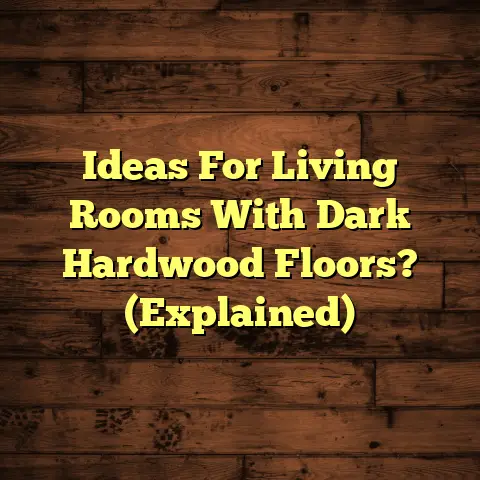Glue Down LVP Flooring? (4 Install Must-Knows!)
Imagine stepping into a room where the cool touch of the floor beneath your feet welcomes you.
The rich texture of the planks underfoot resonates with the soft hum of daily life, each step echoing the warmth of home.
The vibrant colors and intricate wood-like patterns dance in the soft glow of sunlight filtering through the windows, creating a canvas that complements your style.
The visual appeal is captivating, but the real charm lies in the durability and comfort that glue down Luxury Vinyl Plank (LVP) flooring promises.
As a flooring contractor with years under my belt, I’ve seen it all – the good, the bad, and the downright ugly when it comes to LVP installation.
And trust me, glue-down LVP, when done right, is a game-changer.
This article delves into the essential elements of installing LVP flooring using the glue-down method, ensuring that you can create a space that is both beautiful and resilient.
Let’s dive in and get your floors looking fantastic!
Understanding Glue Down LVP Flooring
What is Glue Down LVP Flooring?
So, what exactly is glue-down LVP?
Luxury Vinyl Plank (LVP) is a type of flooring designed to mimic the look of hardwood, tile, or stone, but with the added benefits of being more durable, water-resistant, and often more affordable.
The “glue-down” part refers to the installation method.
Instead of floating (like some click-lock LVP), these planks are adhered directly to the subfloor using a special adhesive.
Think of it like wallpaper, but for your floor!
LVP is typically made of several layers:
- A backing layer: Provides stability and support.
- A vinyl core: This is where the water resistance comes in.
- A printed design layer: This gives the LVP its realistic appearance.
- A wear layer: This top layer protects the design from scratches and wear.
The thickness of this wear layer is crucial; the thicker it is, the more durable the floor will be.
You’ll often see wear layer thickness measured in mils (thousandths
of an inch).
I usually recommend at least a 12-mil wear layer
for residential use and 20-mil or higher for commercial spaces.
The realistic designs are achieved through advanced printing technology, allowing for incredibly detailed textures and patterns that can fool even the most discerning eye.
Benefits of Choosing Glue Down LVP Flooring
Why choose glue-down LVP over other flooring options?
Well, there are several compelling reasons:
Stability: Because it’s glued down, LVP is incredibly stable.
It won’t shift or buckle under heavy foot traffic or furniture.Noise Reduction: Glue-down LVP provides better sound absorption compared to floating floors.
This can be a huge benefit in apartments or multi-story homes.A study by the Acoustical Society of America found that glue-down LVP can reduce impact noise by up to 15 decibels compared to floating floors.
-
Moisture Resistance: LVP is inherently water-resistant, making it a great choice for kitchens, bathrooms, and basements.
While it’s not entirely waterproof (seams can still be vulnerable), it’s much more forgiving than hardwood.
-
Commercial Suitability: Glue-down LVP is tough enough to withstand the rigors of commercial environments, making it a popular choice for offices, retail spaces, and restaurants.
According to a report by Grand View Research, the commercial LVP market is expected to reach \$24.87 billion by 2027, driven by its durability and design versatility.
-
Direct Contact with Subfloor: This provides a solid feel underfoot, unlike some floating floors that can feel a bit “hollow.”
No Transition Strips (Sometimes): In large, open areas, you can often install glue-down LVP without transition strips, creating a seamless look.
This depends on the manufacturer’s recommendations.-
Thinner Profile: Glue-down LVP is typically thinner than click-lock LVP, which can be an advantage when you need to match existing floor heights.
Must-Know Factor #1: Surface Preparation
Importance of a Proper Subfloor
Okay, let’s get down to the nitty-gritty.
I cannot stress this enough: surface preparation is the most critical step in a successful glue-down LVP installation.
I’ve seen countless projects fail simply because the subfloor wasn’t properly prepared.
Think of it like this: you wouldn’t build a house on a shaky foundation, would you?
The same principle applies to flooring.
The subfloor needs to be:
-
Clean: Free of dirt, dust, debris, paint splatters, and anything else that could interfere with the adhesive bond.
Dry: Moisture is the enemy of adhesive.
Excess moisture can prevent the adhesive from bonding properly, leading to warping, bubbling, and eventual failure.I always recommend using a moisture meter to check the moisture content of the subfloor before installation.
For concrete subfloors, the moisture content should ideally be below 3%.
For wood subfloors, it should be between 6% and 8%.-
Level: Any dips, bumps, or unevenness in the subfloor will telegraph through the LVP, creating an unsightly and uncomfortable surface.
A level subfloor ensures that the LVP is fully supported, preventing stress points and premature wear.
Steps for Subfloor Preparation
Alright, let’s get practical. Here’s a step-by-step guide to preparing your subfloor:
Assessment: Start by thoroughly inspecting the subfloor.
Look for cracks, holes, unevenness, and signs of moisture.
Use a straightedge and a level to identify any high or low spots.Cleaning: Sweep, vacuum, and scrape away any debris.
For stubborn stains or residue, use a mild detergent and a scrub brush.
Rinse thoroughly and allow the subfloor to dry completely.Moisture Testing: Use a moisture meter to check the moisture content of the subfloor.
If the moisture levels are too high, you’ll need to address the source of the moisture before proceeding.
This might involve repairing leaks, improving ventilation, or using a dehumidifier.Leveling: If the subfloor is uneven, you’ll need to use a leveling compound to create a smooth, flat surface.
Follow the manufacturer’s instructions carefully, and be sure to allow the leveling compound to dry completely before moving on.Repairing Cracks and Holes: Fill any cracks or holes with a patching compound.
Allow the compound to dry and then sand it smooth.Priming (Optional): In some cases, you may need to apply a primer to the subfloor before installing the LVP.
Primer can improve the adhesion of the adhesive and prevent moisture from migrating into the LVP.Consult the LVP manufacturer’s recommendations to determine whether a primer is necessary.
Tools and Materials You’ll Need:
- Broom and vacuum
- Scraper
- Mild detergent
- Scrub brush
- Moisture meter
- Straightedge and level
- Leveling compound
- Patching compound
- Sandpaper
- Primer (optional)
- Trowel
- Mixing bucket
- Safety glasses and gloves
Common Issues and How to Fix Them:
-
Cracked Concrete: Use a concrete crack filler to repair cracks before leveling.
-
Uneven Wood Subfloor: Sand down high spots and fill low spots with wood filler or leveling compound.
Moisture Issues: Identify and fix the source of the moisture.
Use a dehumidifier to dry out the subfloor.
In severe cases, you may need to replace the subfloor entirely.-
Old Adhesive Residue: Use a scraper and adhesive remover to remove old adhesive before installing the new LVP.
Must-Know Factor #2: Adhesive Selection
Choosing the Right Adhesive
Now that your subfloor is prepped and ready to go, it’s time to talk about adhesive.
Choosing the right adhesive is just as important as preparing the subfloor.
The wrong adhesive can lead to a host of problems, including poor adhesion, bubbling, and even complete flooring failure.
There are two main types of adhesives used for glue-down LVP:
Pressure-Sensitive Adhesive (PSA): This type of adhesive is applied to the subfloor and allowed to become tacky.
The LVP is then pressed into the adhesive.
PSA offers a bit more flexibility during installation, allowing you to reposition planks if needed.Full-Spread Adhesive: This type of adhesive is applied to the entire surface of the subfloor.
The LVP is then immediately placed into the wet adhesive.
Full-spread adhesives provide a stronger, more permanent bond.
Factors to Consider When Choosing an Adhesive:
LVP Manufacturer’s Recommendations: Always follow the LVP manufacturer’s recommendations for adhesive type.
Using the wrong adhesive can void your warranty.Subfloor Material: Different adhesives are designed for different subfloor materials.
Make sure the adhesive you choose is compatible with your subfloor.Moisture Levels: Some adhesives are more moisture-resistant than others.
If you have a subfloor with high moisture levels, choose an adhesive that is specifically designed for those conditions.VOC Content: VOCs (volatile organic compounds) are chemicals that can be released into the air from adhesives.
If you’re concerned about indoor air quality, choose an adhesive with low or zero VOC content.
My Go-To Adhesives:
-
For general use: I often use a high-quality acrylic adhesive that’s compatible with both concrete and wood subfloors.
-
For moisture-prone areas: I opt for a urethane adhesive that’s specifically designed for high-moisture environments.
Application Techniques for Adhesive
Okay, you’ve chosen your adhesive. Now, let’s talk about how to apply it properly.
The key to a successful adhesive application is to use the right trowel and spread pattern.
Here’s a step-by-step guide:
-
Read the Instructions: Always read and follow the adhesive manufacturer’s instructions carefully.
-
Prepare Your Tools: You’ll need a notched trowel, a mixing bucket (if the adhesive requires mixing), and a clean container for the adhesive.
Apply the Adhesive: Using the notched trowel, spread the adhesive evenly over the subfloor.
Hold the trowel at a 45- degree angle and apply consistent pressure to create uniform ridges.The size of the trowel notch will depend on the adhesive and the LVP manufacturer’s recommendations.
Typically, you’ll use a trowel with a notch size of 1/16″ x 1/16″ x 1/16″ or 1/8″ x 1/8″ x 1/8″.
Working Time: Be aware of the adhesive’s working time.
This is the amount of time you have to install the LVP after applying the adhesive.The working time will vary depending on the adhesive type, temperature, and humidity.
Typically, you’ll want to work in small sections, applying only as much adhesive as you can cover with LVP within the working time.
-
Curing Time: Once the LVP is installed, allow the adhesive to cure completely before allowing heavy foot traffic or moving furniture onto the floor.
The curing time will vary depending on the adhesive type, temperature, and humidity.
Typically, it takes 24-72 hours for the adhesive to fully cure.
Tips for Optimal Bonding:
-
Keep the adhesive clean: Avoid contaminating the adhesive with dirt, dust, or debris.
-
Maintain consistent temperature and humidity: Extreme temperature and humidity can affect the adhesive’s performance.
-
Use a roller: After installing the LVP, use a floor roller to ensure that the planks are fully embedded in the adhesive.
-
Avoid walking on the floor: During the curing process, avoid walking on the floor as much as possible.
Must-Know Factor #3: Installation Techniques
Lay Out the Planks
Before you start slapping down planks, take a moment to plan your layout.
This is crucial for achieving a visually appealing and structurally sound floor.
Here’s what to consider:
-
Direction: The direction in which you lay the planks can affect the appearance of the room.
Typically, you’ll want to run the planks parallel to the longest wall in the room to make the space appear larger.
You can also run the planks diagonally for a more unique look.
-
Patterns: There are several different patterns you can use when installing LVP, including:
-
Staggered: This is the most common pattern, where the planks are staggered randomly to create a natural look.
-
Herringbone: This pattern creates a zig-zag effect and is often used in more formal spaces.
-
Straight Lay: This pattern involves laying the planks in straight rows, with no staggering.
-
Starting Point: Choose a starting point that is visible and easy to work from.
Typically, you’ll want to start along a straight wall or a reference line.-
Obstacles: Plan how you’ll handle obstacles such as doorways, corners, and pipes.
Step-by-Step Installation Process
Alright, let’s get to the fun part: installing the LVP!
Here’s a comprehensive guide:
Establish a Reference Line: Use a chalk line to create a straight reference line on the subfloor.
This will ensure that your first row of planks is perfectly straight.-
Apply Adhesive: Apply adhesive to a small section of the subfloor, following the manufacturer’s instructions.
Install the First Row: Place the first row of planks along the reference line, pressing them firmly into the adhesive.
Use a roller to ensure that the planks are fully embedded in the adhesive.Cut Planks to Fit: As you reach the end of the row, you’ll need to cut the planks to fit.
Use a utility knife and a straightedge to make clean, accurate cuts.-
Continue Installing: Continue applying adhesive and installing planks, working your way across the room.
-
Stagger the Seams: When installing the planks, be sure to stagger the seams to create a more natural look.
-
Cut Around Obstacles: When you encounter obstacles such as doorways, corners, or pipes, use a utility knife and a template to cut the planks to fit.
Use Weights: After installing the planks, use weights to hold them in place while the adhesive cures.
This will help to ensure a strong, permanent bond.
Pro Tips:
Use a tapping block: When installing the planks, use a tapping block and a hammer to gently tap them into place.
This will help to ensure a tight, seamless fit.-
Clean up excess adhesive: As you install the planks, be sure to clean up any excess adhesive with a damp cloth.
Take breaks: Installing LVP can be physically demanding.
Take breaks as needed to avoid fatigue.
Must-Know Factor #4: Finishing Touches
Trimming and Edging
Once the LVP is installed, it’s time to add the finishing touches that will give your floor a polished, professional look.
Here’s what you need to do:
Trimming: Trim the edges of the LVP to create a clean, straight line.
Use a utility knife and a straightedge to make accurate cuts.Transitions: Install transition strips where the LVP meets other flooring types, such as carpet or tile.
Transition strips will create a smooth, seamless transition and prevent tripping hazards.Baseboards and Quarter Rounds: Install baseboards or quarter rounds along the perimeter of the room to cover the gap between the LVP and the wall.
Baseboards and quarter rounds will also protect the walls from damage.
Tips for Selecting and Installing Baseboards and Quarter Rounds:
-
Choose a style that complements your décor: Baseboards and quarter rounds come in a variety of styles, so choose one that complements your décor.
-
Use a miter saw: Use a miter saw to make accurate cuts when installing baseboards and quarter rounds.
-
Nail or glue: You can nail or glue baseboards and quarter rounds to the wall.
Post-Installation Care
To keep your glue-down LVP floor looking its best, it’s important to follow a few simple maintenance practices.
Here’s what I recommend:
-
Regular Cleaning: Sweep or vacuum your LVP floor regularly to remove dirt, dust, and debris.
Damp Mopping: Damp mop your LVP floor as needed using a mild detergent and a soft mop.
Avoid using harsh chemicals or abrasive cleaners, as these can damage the finish.Avoid Excessive Moisture: While LVP is water-resistant, it’s not waterproof.
Avoid excessive moisture, such as standing water or spills that are left to sit for extended periods of time.-
Use Floor Protectors: Place floor protectors under the legs of furniture to prevent scratches and dents.
Avoid Direct Sunlight: Prolonged exposure to direct sunlight can cause LVP to fade or discolor.
Use curtains or blinds to block direct sunlight.
Cleaning Techniques and Products:
-
For general cleaning: Use a mild detergent and warm water.
-
For stubborn stains: Use a specialized LVP cleaner.
-
Avoid using: Abrasive cleaners, bleach, ammonia, and wax-based products.
Conclusion: Crafting Your Perfect Space
So, there you have it – a comprehensive guide to installing glue-down LVP flooring.
I hope this information has been helpful and that you’re now feeling confident and inspired to tackle your own LVP project.
Remember, the key to a successful installation is proper preparation, careful execution, and a little bit of patience.
With the right tools, materials, and techniques, you can transform your space into a beautiful and welcoming environment that you’ll enjoy for years to come.
Don’t be afraid to get creative and experiment with different layouts and patterns.
After all, your floor is a reflection of your personal style, so make it your own!
And if you ever feel overwhelmed or unsure about any aspect of the installation process, don’t hesitate to call in a professional.
A skilled flooring contractor can provide expert advice and ensure that your LVP floor is installed correctly and safely.
Happy flooring!





